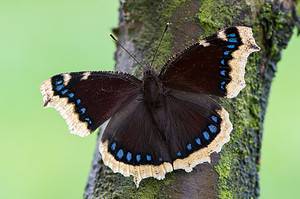Gardens can be a haven not just for plants but for the vibrant life they attract. One of the most delightful visitors to any garden is the butterfly, with its delicate wings and mesmerizing flight patterns. If you’re looking to make your garden a butterfly paradise, the key is choosing the right plants. Vines, with their sprawling growth and vibrant blooms, can be particularly charming to these butterflies. And as a plus, they really add some dimension to your outdoor space!

To help you transform your space into a butterfly magnet, we’ve created a list of the top 10 vines known to attract these beautiful insects. Let’s turn your garden into a butterfly oasis!
1. Japanese Honeysuckle (Lonicera japonica)
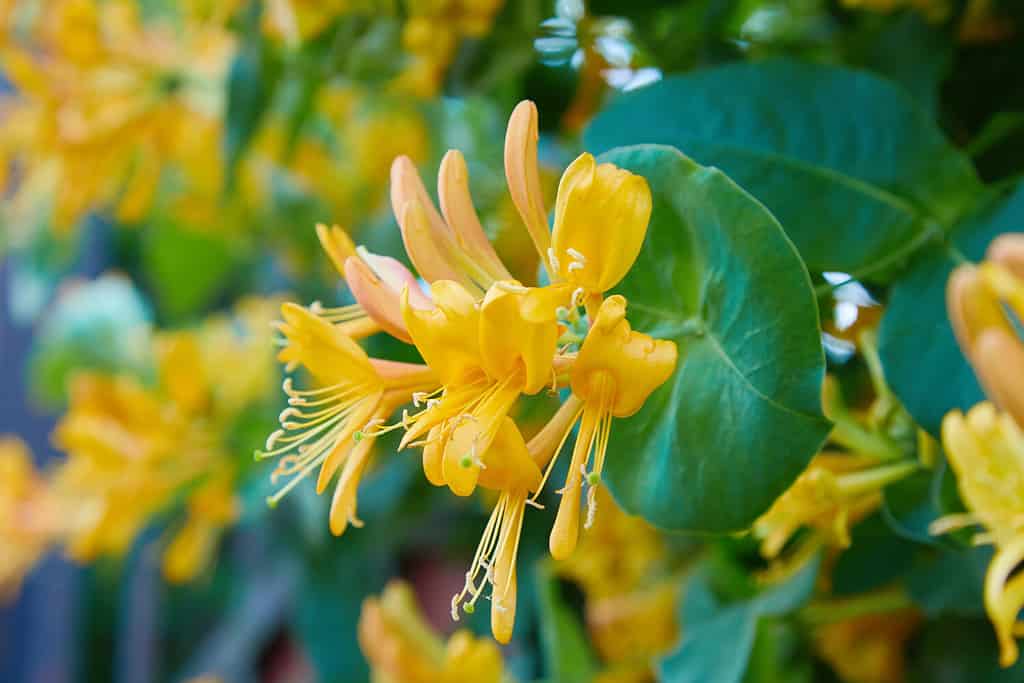
The Japanese honeysuckle is a favorite for butterflies, but be careful, as it is invasive!
©krolya25/Shutterstock.com
Looking to bring butterflies into your garden? Consider planting the Japanese honeysuckle. This vine’s flowers are rich in nectar, making it a prime feeding spot for these fluttering beauties.
The Japanese honeysuckle showcases aromatic, pristine white blossoms that slowly turn to a soft yellow as the seasons transition from late spring to summer’s end. During the warmer months, if conditions are right, it might even bear shiny black berries, which are a magnet for birds.
Sporting a blanket of oval-shaped, deep green leaves, the Japanese honeysuckle remains leafy all through its growth period. While it sheds its leaves in cooler regions, in milder climates, it retains its greenery. Originating from eastern Asia, this aggressive climber can be invasive, unfortunately!
Growing Tips
Perfect for spots with partial shade, this vine thrives in soils ranging from average to well-drained consistency. It can withstand direct sunlight and adjusts well to varied soil types. Remarkably, it’s also resilient in dry conditions. It’s suited for zones 4 through 9 in terms of hardiness.
2. Yellow Passion Flower (Passiflora lutea)
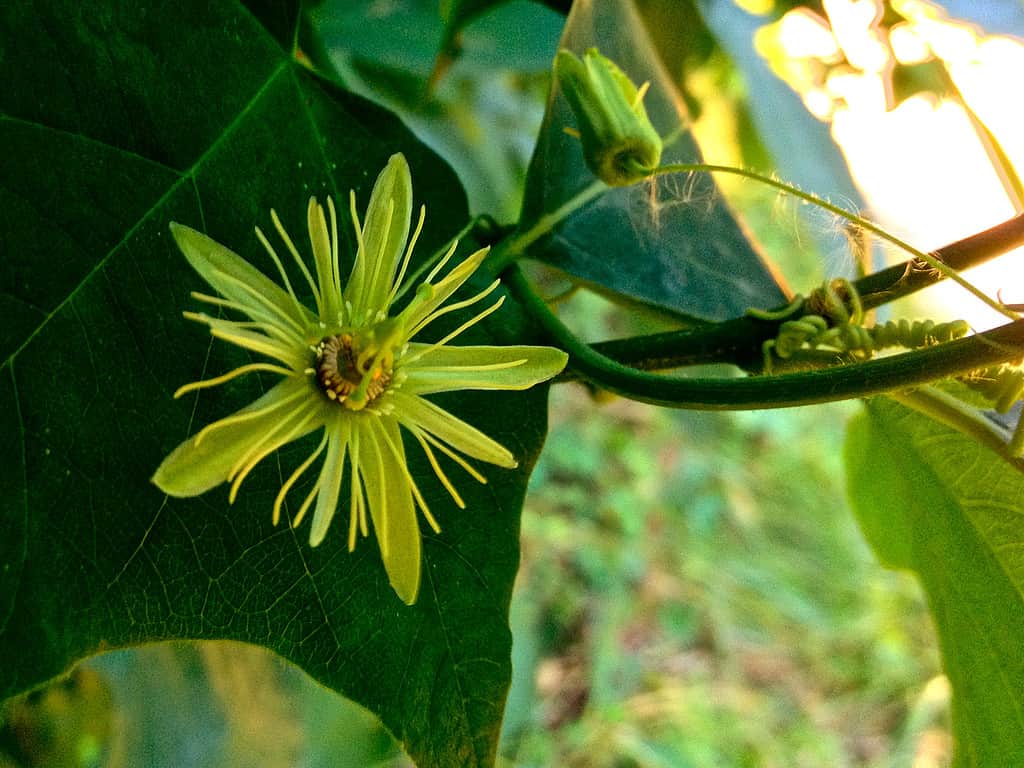
The bright colors of the yellow passion flower vine attract butterflies and other pollinators.
If you aim to attract butterflies, the yellow passion flower is another top choice. These winged beauties flock to its flowers, sipping nectar and occasionally feasting on the pollen. However, be wary of their caterpillars, as these tiny creatures can strip the passion flower of its foliage, potentially harming the plant.
Among passion flower varieties, the yellow passion flower stands out as the most resilient. This radiant vine showcases delicate, pale greenish-yellow blossoms that span an inch in diameter. Not only do these aromatic flowers draw in butterflies, but they also catch the attention of bees and hummingbirds. As the season progresses, these blooms give way to tiny black berries favored by birds and other small wildlife.
Adding to its charm, the yellow passion flower features silvery-green, softly lobed leaves. An interesting note: its flowers are edible, making for pretty additions to salads. Originating from the eastern and south-central regions of the U.S., this vine finds its home in woods, forests, and coastal regions. Whether climbing a fence, wrapping around a trellis, or blanketing the ground, it adds an organic touch to any garden.
This vine is not just for show; it plays a vital role in the life cycle of certain butterflies like the Gulf fritillaries, Julia butterflies, and zebra longwings.
Growing Tips
For optimal growth, plant the yellow passion flower in sunlit or partially shaded spots with rich, well-draining soils. It has a preference for sandy or gravelly soils and thrives in hardiness zones 5 through 10.
3. Tricolor Nasturtium (Tropaeolum tricolor)

The flower on the left is on a
Tropaeolum tricolorvine.
©Elena Koromyslova/Shutterstock.com
Butterflies can’t resist the prolonged flowering of the Tropaeolum tricolor, making repeat visits throughout its bloom time. The tricolor nasturtium is known for its vibrant display of tricolor blossoms from winter through early summer. Each small yellow bloom, measuring about an inch, is accentuated by a vivid orange-red calyx with purple tips and an extending red or purple spur.
These radiant blooms not only offer months of visual delight but also stand out strikingly against the plant’s soft, bright green leaves. Though this vine appears fragile, it’s surprisingly resilient, ranking among the longest-flowering members of the Tropaeolum family. Most gardeners value it for its ornamental charm.
This vine’s excellence has been recognized with the distinguished Award of Garden Merit from the Royal Horticultural Society.
Growing Tips
For optimal growth, place the tricolor nasturtium in a sunny spot with rich, well-draining loamy soil. While it can handle a bit of shade in regions with intense summer heat, it’s mostly fuss-free. However, be watchful for potential pests like whiteflies and red spider mites. It thrives best in hardiness zones 8 through 10.
4. Canary Creeper (Tropaeolum peregrinum)
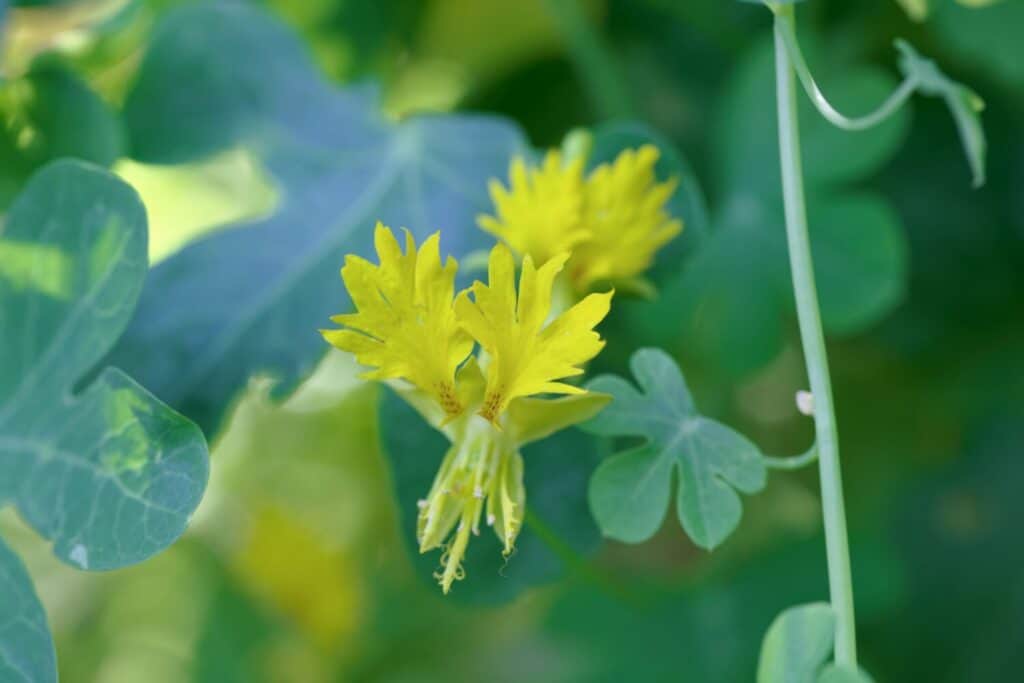
This vine provides sweet nectar, which attracts butterflies.
©ChWeiss/Shutterstock.com
The canary creeper, another member of the Tropaeolum family, is a butterfly favorite due to the sweet nectar it provides. This frost-sensitive vine showcases an abundance of vibrant yellow flowers, which bloom from summer until the chill of the first frost arrives. The unique flower design features two large, fringed upper petals resembling canary wings, accompanied by three smaller lower ones.
The delicate blue-green leaves, which have five deep lobes and span up to 2 inches, provide a beautiful backdrop to these sunny blossoms. In cooler regions, it’s advisable to cultivate the canary creeper as an annual.
Growing Tips
For the best growth results, this vine prefers sunny locations with well-aerated soil. Before winter arrives, a protective mulch layer can help shield it from frost. While it’s typically resistant to diseases, be on the lookout for common pests like aphids, caterpillars, and flea beetles. It flourishes best in hardiness zones 10 and 11.
5. Dutchman’s Pipe (Aristolochia macrophylla)

A favorite of the pipevine swallowtail butterfly is the Dutchman’s pipe.
©Adrian Eugen Ciobaniuc/Shutterstock.com
The Dutchman’s pipe is a crucial food source for the caterpillars of the pipevine swallowtail butterfly. Additionally, its fragrant flowers not only charm butterflies but also release a scent that lures flies, aiding in the pollination process.
Characterized by its robust growth, the Dutchman’s pipe is a deciduous vine adorned with sizable, heart-shaped leaves that are vibrant green on top and light silver underneath. When grown on structures like trellises or fences, these leaves overlap, forming a thick green curtain.
During the transition from spring to summer, this vine showcases unique pipe-like flowers that hang from beneath the leaves. Displayed either individually or in small clusters, these greenish-yellow blooms are speckled with hints of yellow and deep burgundy. Due to the dense leaf coverage, these flowers can sometimes be hidden. Nevertheless, this vine is often valued more for its verdant leaves than its blossoms. The nectar-rich flowers are also a favorite among hummingbirds.
Growing Tips
For optimal growth, the Dutchman’s pipe thrives in nutrient-rich, moist, and well-draining soils, either under full sun or partial shade. It’s essential to keep the soil consistently moist, as the plant doesn’t favor dry conditions. Additionally, a sheltered spot away from harsh winds is ideal.
This vine generally remains free from major pests or diseases. To maintain its shape and promote branching, it’s best to prune it during dormancy and occasionally pinch its growing tips. It’s best suited for hardiness zones 5 through 8.
6. Carolina Jessamine (Gelsemium sempervirens)
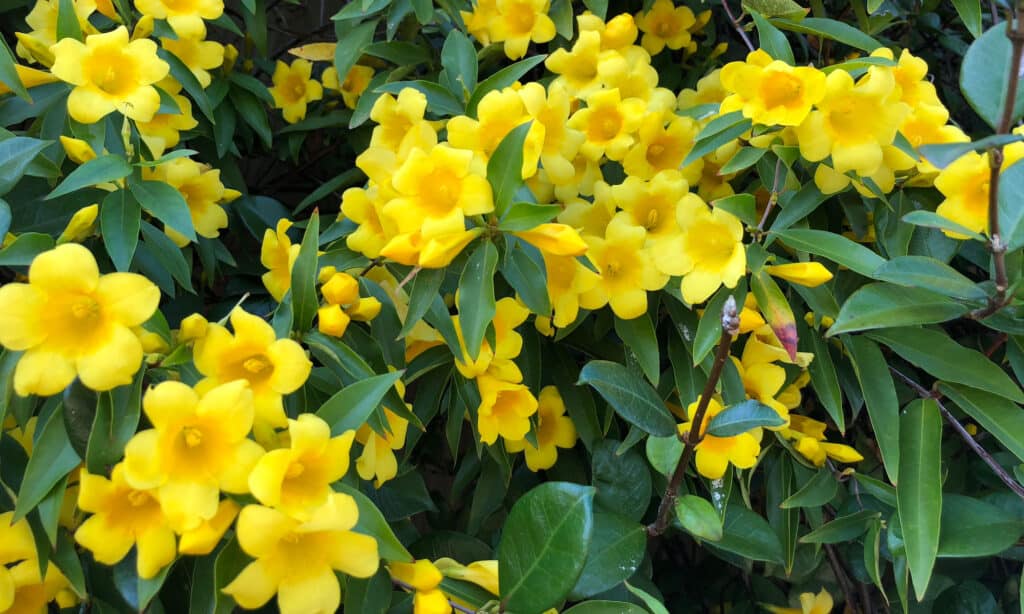
The aromatic blooms of the Carolina jessamine help attract pollinators, such as butterflies.
©iStock.com/Campwillowlake
The Carolina jessamine announces spring’s arrival with its fragrant trumpet-like flowers as early as February. These aromatic blossoms are a favorite among various pollinators, including bees and butterflies.
Prominent for its breathtaking display, the Carolina jessamine is an evergreen vine decorated with an abundance of sweet-smelling, buttery yellow, or rich golden-yellow blossoms. These flowers make their appearance primarily from the end of winter to the start of spring, though they might surprise you with a few blooms in the fall.
These blossoms sometimes have subtle orange highlights inside and can either stand alone or group together, creating a captivating cluster. With their bright hues and scent, they naturally draw in bees, hummingbirds, and, of course, butterflies. This beautiful display is complemented by its glossy, ovate leaves that have a fresh green hue.
Notably, it holds the honor of being South Carolina‘s official flower and has also been recognized with the esteemed Award of Garden Merit from the Royal Horticultural Society.
Growing Tips
For those considering the Carolina jessamine for their gardens, this vine flourishes in sunlight but doesn’t mind a bit of shade. It thrives in organically rich, moderately fertile soils that are kept moist. While it flowers best under the full sun, it’s wise to shield it from cold gusts. During its growth phase, regular watering and monthly fertilizing will keep it at its best.
Generally, this resilient vine doesn’t face major threats from pests or diseases and is suitable for regions with a hardiness rating between 7 and 10.
7. Downy Clematis (Clematis macropetala)

The downy clematis is a great vine choice for those wanting to attract butterflies.
©Rey Rojo/iStock via Getty Images
Butterflies can’t resist the sweet nectar of the downy clematis. This vine is an excellent choice for anyone wanting to enhance their butterfly garden.
Sturdy and quick to bloom, the downy clematis is a deciduous climber, showcasing elegant, drooping, lantern-like flowers in a delicate shade of lilac blue. Measuring about 2-3 inches in width, each flower boasts four slender petals surrounded by either blue or cream thread-like stamens.
This charming vine flowers mainly in mid-spring, but don’t be surprised if it treats you to another round of blossoms come midsummer. Post-blooming, it offers another visual treat: airy, shimmering seedheads that linger throughout summer, amplifying the plant’s allure. Its leaves, finely cut and toothed, have a defined serration on the edges.
Growing Tips
Downy clematis thrives best in damp, well-aerated soils. While they bask under direct sunlight or partial shade, they do appreciate their roots staying cool. A common gardening tip for these vines: they love sunlit tops and shaded bottoms.
To ensure the roots remain cool, you can either plant companion plants nearby or place pebbles or flat stones around its base. This vine is well-suited for regions rated 4 to 9 in hardiness.
8. Common Hop (Humulus lupulus)

Common hop is another vine you can plant to attract butterflies to your yard.
©Akchamczuk/iStock via Getty Images
The inviting citrus scent of common hop blossoms is a delight for butterflies. Known for its resilience and beauty, the common hop is a robust perennial vine. Its winding stems are adorned with deep green leaves characterized by deep lobes and jagged edges. As late summer transitions to early fall, this vine showcases clusters of delicate, sweet-smelling pale green flowers that evolve into unique, papery fruits reminiscent of pinecones.
Though the plant retreats during the winter months, it reliably returns every spring. It’s a fantastic option for adding natural beauty to a bare fence or shading a pergola.
Growing Tips
This vine flourishes in both direct sunlight and partial shade and favors moderate, well-aerated, and damp soil. Once settled, it can withstand periods of drought. As the common hop grows, it needs a sturdy structure to twine around, such as walls, fences, or pergolas.
It serves as a quick natural screen, effortlessly concealing less appealing views or even acting as a dense ground cover on sloping terrains. It’s suited for areas with a hardiness rating between 4 and 8.
9. Pacific Pea (Lathyrus vestitus)

An evergreen plant, the Pacific pea vine attracts butterflies with its fragrant blooms.
©Jared Quentin/iStock via Getty Images
The Pacific pea vine is an evergreen plant that showcases a vibrant array of pea-like flowers ranging from bold violet to soft white colors. These fragrant blossoms, reminiscent of grapes, bloom from early spring to late summer, drawing in butterflies and moths.
Its elegant flowers grow on slender stems dotted with tiny green leaflets. These leaflets end in tendrils that assist the vine in clinging to its surroundings. As the season progresses, these blossoms develop into pea pods. When these pods mature, they burst open, revealing round seeds inside.
This versatile vine can either creep on the ground or elegantly climb nearby plants and structures. A bonus: its roots spread efficiently, acting as a natural barrier against soil erosion.
Originating from the western regions of North America, the Pacific pea is commonly found amidst the forests and shrublands of California.
Growing Tips
It thrives best under the warmth of direct sunlight or in areas with light shade. The ideal soil for this vine is moist, with a mix of sand and clay, and has good drainage. Once settled in, it can withstand dry conditions. It’s best suited for regions with a hardiness level between 9 and 10.
10. Mexican Flame Vine (Pseudogynoxys chenopodioides)

The Mexican flame vine is a magnet for butterflies and bees.
©jasony00/iStock via Getty Images
If you want to invite several butterflies to your garden, the Mexican flame vine is a must-have. From the vibrant red admirals and regal monarchs to the unique cloudless sulphurs, many butterflies can’t resist its nectar-rich blooms.
The Mexican flame vine boasts glossy, arrowhead-shaped foliage and is renowned for its striking clusters of flowers. These vibrant orange-red blossoms, highlighted by golden centers, delight the eyes from late spring to fall. If you’re in an area with mild winters, you might even enjoy these blossoms year-round.
Besides being a magnet for butterflies, these blossoms also appeal to bees. As they age, their colors shift to a deeper red, eventually producing fluffy, dandelion-esque seeds. This vine is versatile, looking splendid on a trellis, gracefully spilling over walls, or adding a touch of nature to hanging baskets.
Growing Tips
For the best growth, plant it in well-drained soil and ensure it gets ample sunlight. It can handle a bit of shade, especially in regions with scorching summers, and once established, it’s pretty drought-resilient. Whether draped over garden structures or in baskets, this vine thrives in zones ranging from 9 to 13.
Summary of the Best Vines That Attract Butterflies
| Number | Vine | Botanical Name |
|---|---|---|
| 1 | Japanese Honeysuckle | Lonicera japonica |
| 2 | Yellow Passion Flower | Passiflora lutea |
| 3 | Tricolor Nasturtium | Tropaeolum tricolor |
| 4 | Canary Creeper | Tropaeolum peregrinum |
| 5 | Dutchman’s Pipe | Aristolochia macrophylla |
| 6 | Carolina Jessamine | Gelsemium sempervirens |
| 7 | Downy Clematis | Clematis macropetala |
| 8 | Common Hop | Humulus lupulus |
| 9 | Pacific Pea | Lathyrus vestitus |
| 10 | Mexican Flame Vine | Pseudogynoxys chenopodioides |
The photo featured at the top of this post is © Jared Quentin/iStock via Getty Images
Thank you for reading! Have some feedback for us? Contact the AZ Animals editorial team.





